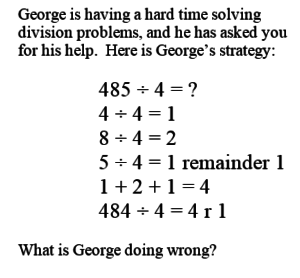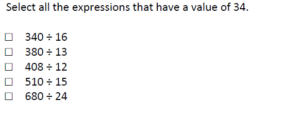Find whole-number quotients of whole numbers with up to four-digit dividends and two-digit divisors, using strategies based on place value, the properties of operations, and/or the relationship between multiplication and division. Illustrate and explain the calculation by using equations, rectangular arrays, and/or area models.
Students are able to…
- Model division using a variety of strategies (creating equal groups with base-ten blocks, rectangular arrays, area model, partial quotients, standard algorithm) and make connections between the strategies. (it is not the intent of the standard that students master the traditional algorithm for division in 5th grade, however if some students have mastered other methods they may begin to use place value understanding to explore and justify the algorithm)
- Use estimation to solve division problems and check reasonableness of quotients.
- Explain their reasoning using pictures, words, and numbers.
- Describe the place value inherent when using algorithms.
Students are able to…because teachers:
- Facilitate exploration of strategies and connecting the strategies through discussion.
- Model the use of precise place value language when using any strategy or algorithm including the use of the standard algorithm for those students who are ready.
- Provide a variety of real-world problems that allow students to utilize estimation strategies, including checking for reasonableness of results.
Questions to ask students:
- Ask a student that is using the standard algorithm how their strategy connects to place value. (Example: 128 ÷ 5)
- Sample answer that indicates understanding: I must decompose the 100 into 10 tens so that I can put 2 tens into each of the 5 groups equally. There will be 2 tens and 8 ones left. I must decompose the 2 tens into 20 ones to add to the 8 ones for a total of 28 ones. I can place 5 ones equally into each of the 5 groups. There will be 3 ones left over.
- Sample answer that indicates an incomplete understanding or misconception: First I divide, then I multiply, next I subtract, and drop down the next digit. I repeat the steps as needed.
- Ask students if there is another way to solve the division problem.
- Could solve it using repeated subtraction or using an unknown factor multiplication problem.
- Additionally, students may use a less efficient algorithm such as partial quotients. This could indicated that they understand division, but do not yet understand the standard algorithm. Students needs support with connecting the algorithms they do know to the standard algorithm.
- Ask students to explain how they know their answer is reasonable.
- Students should have an estimation strategy they can employ to develop an approximation of the solution.
FSA Notes
Cognitive Complexity Level: Level 2- Basic Application of Skills & Concepts
Achievement Level Descriptions:
2. finds whole-number quotients of whole numbers (with up to two-digit dividends and two-digit divisors), using rectangular arrays or area models
3. finds whole-number quotients of whole numbers (with up to four-digit dividends and two-digit divisors), using strategies based on place value, the properties of operations, and/or the relationship between multiplication and division; illustrates and explains the calculation by using equations, rectangular arrays, and/or area models
4. identifies or creates multiple division expressions that have a given quotient
5. solves for a quotient by continuing the steps of a given division strategy
Assessment Limits: Division may not exceed four digits by two digits.
Context: Allowable
Additional Resources:
Additional in depth content knowledge:
Video: Dividing using partial quotients
Sample Formative Task:
[divider] [/divider]
[divider] [/divider]
Resources/Tasks to Help Your Child at Home:
- Learn Zillion Video- Divide 4-digit dividends by 2-digit divisors by estimating and adjusting the quotient- https://learnzillion.com/lesson_plans/7385-divide-4-digit-dividends-by-2-digit-divisors-by-estimating-and-adjusting-the-quotient/
- Use estimation to help explain whether the quotient is reasonable.
801 ÷ 9 = 83

